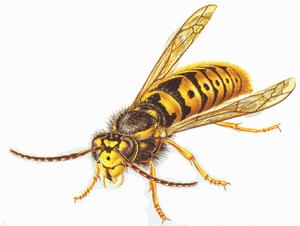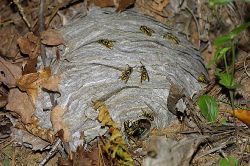| LIFE CYCLE INFORMATION |
|
All wasps will defend their nests, but the Yellow Jackets and hornets are the most aggressive. They can be distinguished from bees by their thin "waists." Bees are thick-wasted. They fold their wings lengthwise when at rest. Like all wasps, yellow jackets prey on a variety of insects and other arthropods. Yellow jackets will also forage on foods that people eat, especially sweets and meats. They are considered beneficial insects, eating other insects. The yellow jacket colony will remain active for only one summer, after which the queens will fly away to start more colonies. The remaining ones, die at the end of the summer, the nest is not reused. IDENTIFICATION: Size: 5/8 to 1 inch They usually nest in the ground, but will nest also in railroad ties, wall voids, and other above ground locations. In the spring, most yellow jackets will feed on insects. Many homeowners see "bees" flying around their hedges. These "bees" are usually yellow jackets and are there to eat insects on the foliage. Spraying the hedges with an appropriate insecticide will kill the food source of the yellow jackets, and they will soon leave the area. In the fall, wasp colonies have come the largest size, and foraging workers may be a serious nuisance as they search for food people eat or discarded food. If a colony is disturbed, they can become very aggressive and sting. For most a sting is temporary, but painful, but for allergic individuals as single sting may result in a serious reaction, requiring medical treatment. RECOMMENDED MEASURES OF CONTROL: Sanitation( to eliminate possible food sources) is important to reduce build up of foraging population during the summer to mid autumn . Trash containers should be kept closed and open containers should be emptied regularly. Nests should be located during the day, so you can see the workers entering and exiting all day. Mark the entry points. Any treatments should be done at night, because they are all in the nest. They don't see well at night and your chances of being stung are greatly reduced. Treat the nest with a pyrethrum aerosol such as CB-80 PYRETHRUM Pyrethrum forms a gas which will fill the cavity, killing the yellow jackets. Check the nest the following day, to see if the yellow jackets are indeed dead by lack of activity. RETURN TO TOP |

